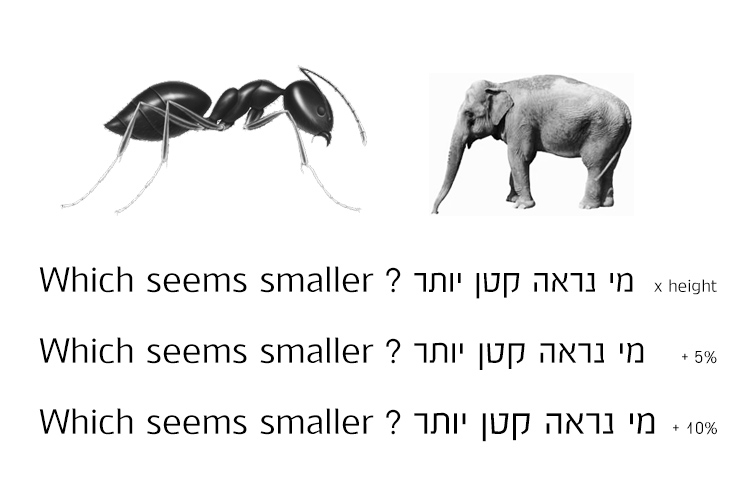Multy lingual harmonisation

Latin and Hebrew scripts are very different by nature and it is quite an interesting harmonising challenge.



Comments
-
Antique Olive.1
-
Though it's worth noting that Antique Olive's lowered crossbar was necessitated by its tiny ascender space. It's not arbitrary the way the above example seems.Nick Shinn said:Antique Olive.1 -
The size of the Hebrew letters relative to the Latin looks small to me. This is in part due to the older convention with which I am in familiar, in which Hebrew letters are taller than the Latin x-height, but I think the details and spacing of the Hebrew also contribute to this: Hebrew letters involve tighter, more complex forms than Latin, so need a bit more scale in order to breathe.4
-
You say you are trying to make this a clean text/body typeface. That really ought to rule out extreme choices like the oddly low crossbar on the f. Generally the f and t crossbars are the same height btw.
Plus, it just looks weird with no other odd or unusual proportions and heights in the font. In this case, it just looks like a mistake.
1 -
Well, the big head of ‘e’ feels a bit unusual for me, too, but seeing the ‘f’ I thought it was intentional and I actually quite like it. Not a corporate clean sans feel though, agreed.2
-
Another precedent with a lowered crossbar on f and t is Frutiger’s Vectora. For the same reason as Craig mentioned with Antique Olive — tall x-height/short ascent.
2 -
I don't know anything about Hebrew script, but intuitively I'd place them at small-cap height with respect to the Latin. After all, small caps are also squarish, extenderless letters designed to visually fit into mixed case.
1 -
Thanks a lot for all the insightful comments.
I have changed the sizes to work better, now the overall Hebrew height is a bit larger than the Latin x-height.
Still leaving the /f crossbar low to feel it a bit longer, and testing another, more squared, variation (2) with higher contrast in the joints. (Both variations are merely drafts).
0 -
The f crossbar reminds me of the ascending arm of r in Palatino Sans. The designer was in love with the idea—so much so that he couldn’t see that it was a bad idea. And no matter how immaculately drawn it is, it will always make a reader stop and look and forget what she was reading. A chip in the rim of a crystal goblet.4
-
Only flirting at the momentJames Puckett said:... in love with the idea—so much...
But the lower crossbar doesn't seems to me as severe as the raised /r in Palatino Sans.
Christian Thalmann Using small caps will reduce the font's usability too much imo.
0 -
How should Hebrew and Latin stroke weights be balanced, if Hebrew should be slightly bigger than Latin x-height? Harmonize with the lower case stems, the upper case stems or somewhere proportionally in between?0
-
For the record, I was suggesting to draw the Hebrew glyphs at small-caps height, not making small-caps the default Latin letters.Ofir Shavit said:
0 -
Oh, sorry for misunderstanding that. I understand that small-caps height is also "flexible" (from x-height to a bit larger).Christian Thalmann said:For the record, I was suggesting to draw the Hebrew glyphs at small-caps height, not making small-caps the default Latin letters.
Simon Cozens - I'd go for the lower case stem's weight because anyway the textures of the Latin and Hebrew scripts are different so I think it is better to keep the stroke's intensity the same with the closest and most common match.
Here's a demo page of a multi script font in which the Hebrew script is at the lower case height and stem weight (and if you'll change the displayed font to Arial you could see it is higher and thicker than the lower case Latin)0 -
Four directions for the Latin script (all drafts!), I think option 1 is the best fit so far, even though I like 3.0
-
-
I recently drew my first Hebrew glyph set and had forgotten all about this thread. I put the Hebrew characters at cap size. Is that a problem? The font is for display purposes, and I envision it being used in all-caps mode a lot, so it would fit there.
0 -
Hebrew at Cap height is better to pair with all-caps Latin headlines. If the font is not meant to be used for text I don't think it is a problem, even if some size corrections will be required with normal capitalization headlines. The style matching is more important, would love to see it.0
-
...and I would love to hear your opinion of it.
 It's right here:
It's right here:
http://typedrawers.com/discussion/comment/17522/#Comment_17522
0 -
Ofir, the Latin letters are very much full width, whereas the Hebrew is quite condensed and tightly spaced, save for one conspicuously wide glyph: the shin. The squared corners of the heh and some others make for a vertical spikiness, which is not comparable to anything in the Latin. One would never know the fonts are related, except for the stroke weight.
One thing you might try to achieve greater harmony is reduce the height of the figures, below cap height, though not as low as the Hebrew is currently. Then make the Hebrew as tall as the new figures. Cap-high figures in Latin are not a hard-and-fast rule, just a bad habit.
0 -
Scott-Martin, The Hebrew version has already been released with its 21 styles so I'm trying to tailor the Latin to it.
I will examine condensing the Latin and lowering the figures. I do like Hebrew at x-height though.
Thanks!0 -
Here's a fast test with slightly condensed Latin (and humanized figures). The Hebrew has much more white. (Open both images and switch the browser's tabs to compare)

Btw, this Latin version has a bit less contrast in comparison to the previous image I've uploaded.0 -
Ofir, this is better, though I still feel the Hebrew is small and could use more air (part of the same problem, I think). In the least, I think you should consider making it small cap height. As it is now, the Hebrew looks smaller than the Latin, even though it is at x-height. This is a visual phenomenon I've observed before. It has to do with how the straight-sided letters, of which there are many in Hebrew, are spaced. The shin still sticks out as wide, and the ayin and alef a bit, too, though less so. In old metal type, the shin was was never more than 25% wider than the majority square letters, and in many fonts it was also square. (There was no in-between width.)
You should consider redrawing the a and e, to make them more stylistically compact, not just electronically narrower. The cap A looks very wide, and stylistically out of place with its low crossbar. It would help to see all the caps.
I wondered what pre-existing Latin font I would use with your Hebrew. The answer came quickly: FF Unit. I don't know how compatible the weight is, but I believe the design would be more harmonious with the Hebrew than your Latin.
There's not much compatibility between Hebrew and Latin letterforms, so you have to think about joints, angles, and curved shapes to achieve some harmony--if harmony is what you want. It may be easier to do that starting with Latin than it is starting with Hebrew.
1 -
I start to notice the smallness effect you're talking about, I think it might have something to do with the density of details, which is higher in Latin than Hebrew, too.
Here's a quick test...
But there is the color problem, Hebrew has more white in it (that's why I think the color comparison is better in the non-condensed Latin), and the bigger it gets the lighter it gets.
In this test I think the 5% option is better.
1 -
The +10% looks best to me, but you should think about the line weight. It may well be that 9% or 11% or 12% will look better still.
What are you using this for? My perspective is that of a designer of multilingual prayer books—English-Hebrew-transliterated Hebrew—so my perspective is largely literary. In these books, it's preferable for the Hebrew to have slightly greater presence than the Latin. However, for commercial applications, you might prefer a more equal treatment. As I said earlier, though, I think the Hebrew looks smaller when it is at the Latin x-height.
1 -
It is for commercial needs mostly, both print and screen (Not for too long texts)
Link
I'll keep on updating
Thanks a lot for your advices!
0 -
-
The apparent size is now looking quite balanced (although some in-line settings would help gauge that better). There is a hidden problem concerning density however: since Hebrew requires a lot less linespacing, when you set parallel text blocks with ideal linespacing it will look darker. If you provide enough finely gradated weights (Variable Fonts yay! :-) this can be solved by judicious typographers, but otherwise it might sometimes require compromises on the linespacing end and/or the density end.
Concerning the character of the letterforms, I don't have nativity in Hebrew so can't really tell, but the guideline I would suggest is this: Does the Hebrew convey to its readers the same mood that the Latin conveys to its readers? This is much more important than the literal sharing of shapes.
The cavalier transferring of shapes between writing systems is the single biggest trap in multi-script type design.
"The hidden harmony is better than the obvious one."
– Heraclitus
> The f crossbar reminds me of the ascending arm of r in Palatino Sans. The designer was in love with the idea—so much so that he couldn’t see that it was a bad idea.
The ascending "r" in Palatino Sans* is actually one of its best features. The original Cheltenham did that, and because it contributes divergence (unlike the ill-advised descending "f" in Fedra) without drawing attention from previous fixations it is good in the long term. Not to mention its spacing advantages. Readers are much more flexible than some type designers give them credit for, and a type designer's role is not to merely maintain the status quo.
* Related: http://typographica.org/typeface-reviews/palatino-sans/
So keep asking yourself what shifting crossbars achieve, and take risks you believe in.
1 -
I'm on the side that finds the ascending “r” arm distracting. It draws considerable attention to itself, which is not a good thing for a common glyph in an otherwise subtle typeface.0
Categories
- All Categories
- 46 Introductions
- 3.9K Typeface Design
- 487 Type Design Critiques
- 563 Type Design Software
- 1.1K Type Design Technique & Theory
- 656 Type Business
- 861 Font Technology
- 29 Punchcutting
- 520 Typography
- 119 Type Education
- 324 Type History
- 77 Type Resources
- 112 Lettering and Calligraphy
- 33 Lettering Critiques
- 79 Lettering Technique & Theory
- 558 Announcements
- 94 Events
- 114 Job Postings
- 170 Type Releases
- 179 Miscellaneous News
- 276 About TypeDrawers
- 54 TypeDrawers Announcements
- 120 Suggestions and Bug Reports









